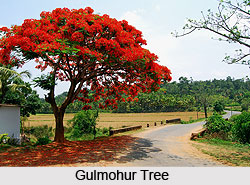 Gulmohur is regarded as one of the most beautiful tropical trees in the world. The Gulmohur grows well in the tropical and subtropical areas of the world. It prefers the sun and does not like shade and doesn"t grow well in shaded areas. It is native to Madagascar but it under threat in the wild there because of habitat destruction. The tree is an evergreen deciduous with the branches spreading wide and forming an umbrella like canopy. This beautiful plant can tolerate salty conditions also and can be grown in coastal areas. This plant is well known for the comfortable shadow it provides with the help of its feathery foliage. In the central Indian deciduous forest area the flowering season of the plant is during April to June. During this time the trees become leafless.
Gulmohur is regarded as one of the most beautiful tropical trees in the world. The Gulmohur grows well in the tropical and subtropical areas of the world. It prefers the sun and does not like shade and doesn"t grow well in shaded areas. It is native to Madagascar but it under threat in the wild there because of habitat destruction. The tree is an evergreen deciduous with the branches spreading wide and forming an umbrella like canopy. This beautiful plant can tolerate salty conditions also and can be grown in coastal areas. This plant is well known for the comfortable shadow it provides with the help of its feathery foliage. In the central Indian deciduous forest area the flowering season of the plant is during April to June. During this time the trees become leafless.
Different Names of Gulmohur
Commonly known as "Gulmohur" or "Radhachura" in Bengali, is a tropical plant found in many tropical countries including India. Apart from the common name the plant has several regional names which have been assigned to it. For instance "Doddartna-Grandhi" is the Kannad version of the plant and it is known as "Alasippu" in Malayalam. In other languages like Marathi, Tamil and Telegu the plant is known as "Gulmohur", "Mayarum" and "Erraturayl" respectively. The English name of this tropical plant is "Royal Poinciana" and the botanical name of this plant is "Delonix regia". In the Indian state of Kerala, Royal Poinciana is called "Kaalvarippoo" which means "The Flower of Calvary". The plant has originated in Madagascar and is cultivated in many of the warmer tropical countries. In India it is planted along road sides and gardens especially in the warmer parts.
Parts of Gulmohur
 The tree grows to a height of about 20-25 feet. It has a grey brown bark and flowers which are crimson red to scarlet orange in colour. The flowers are the most striking part of this tree and it is flamboyant in the display of its flowers. The flowers are pollinated by sunbirds. The fruits or the pods of the plant are hard and long in structure and contains a huge number of mottled brown seeds. The seed pods are extremely long, flattened and strap shaped having up to 50 seeds in each one. They are turn deep brown when mature.
The leaves are large and doubly pinnate having 10-25 pairs of pinnate. The leaves have a feathery feel and are bright green in color. It remains green throughout the year wherever there is enough water.
The tree grows to a height of about 20-25 feet. It has a grey brown bark and flowers which are crimson red to scarlet orange in colour. The flowers are the most striking part of this tree and it is flamboyant in the display of its flowers. The flowers are pollinated by sunbirds. The fruits or the pods of the plant are hard and long in structure and contains a huge number of mottled brown seeds. The seed pods are extremely long, flattened and strap shaped having up to 50 seeds in each one. They are turn deep brown when mature.
The leaves are large and doubly pinnate having 10-25 pairs of pinnate. The leaves have a feathery feel and are bright green in color. It remains green throughout the year wherever there is enough water.
Cultural Significance of Gulmohur
There is a popular belief among Saint Thomas Christians of Kerala that when Jesus was crucified, there was a small Royal Poinciana tree nearby his Cross. It is believed that the blood of Jesus Christ was shed over the flowers of the tree and this is how the flowers of Royal Poinciana got a sharp red colour.
Medicinal Value of Gulmohur
The plant has several medicinal uses like it is used to treat constipation, inflammations, arthritis and hemiphlagia. Thus it can be said that apart from being a treat to the eyes of an onlooker, the plant also has many medicinal uses which makes Gulmohur to stand out in the crowd.











